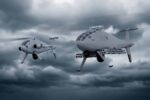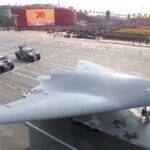China has reportedly commenced construction of its most ambitious naval platform to date—the Type 004 nuclear-powered aircraft carrier. Intended to rival the U.S. Navy’s Gerald R. Ford-class supercarriers in power projection and technological sophistication, the Type 004 marks a pivotal step in the People’s Liberation Army Navy’s (PLAN) transition into a true blue-water force.
Strategic Leap: From Conventional to Nuclear Propulsion
The Type 004 will be China’s fourth aircraft carrier and its first with nuclear propulsion. This shift from conventional steam turbines—used in the Liaoning (Type 001), Shandong (Type 002), and Fujian (Type 003)—to nuclear power represents a significant leap in operational endurance and sortie generation capability.
Nuclear propulsion will allow the Type 004 to remain at sea for extended periods without refueling—potentially matching or exceeding the deployment cycles of U.S. supercarriers. It also enables greater electrical output for energy-intensive systems such as electromagnetic catapults and directed-energy weapons.
According to multiple defense analysts and satellite imagery reviewed by open-source intelligence platforms like Naval News and CSIS’ Asia Maritime Transparency Initiative (AMTI), initial hull sections are being assembled at Jiangnan Shipyard near Shanghai—a facility that has been expanded significantly over the past five years in anticipation of large-deck warship production.
Technological Enhancements: EMALS and Advanced C4ISR
The Type 004 is expected to feature an Electromagnetic Aircraft Launch System (EMALS), similar in concept to that used on the USS Gerald R. Ford. This system reduces wear on airframes compared to steam catapults and allows for quicker launch cycles with more precise control over launch parameters.
In parallel with EMALS integration, Chinese state media have hinted at breakthroughs in integrated electric propulsion (IEP) systems that would feed high-power sensors and future weapons such as railguns or high-energy lasers—though these claims remain unverified by independent sources.
C4ISR capabilities are also expected to be significantly enhanced aboard the Type 004. The ship will likely incorporate an expanded suite of AESA radar arrays, satellite communications uplinks compatible with China’s Beidou constellation, and AI-assisted combat management systems for real-time threat assessment and battle coordination.
Carrier Air Wing Evolution: Toward Fifth-Generation Naval Aviation
The air wing composition of the Type 004 remains speculative but is likely to include:
- J-35 stealth fighters—a navalized fifth-generation platform under development by Shenyang Aircraft Corporation
- KJ-600 fixed-wing airborne early warning (AEW) aircraft with twin turboprop engines
- Unmanned combat aerial vehicles (UCAVs) potentially derived from GJ-11 Sharp Sword or similar stealthy designs
- Z-20 helicopters for anti-submarine warfare (ASW) and utility missions
The inclusion of stealth-capable fighters would mark a generational shift from current PLAN air wings composed primarily of J-15 Flanker derivatives launched via ski-jump ramps on earlier carriers.
Industrial Base Expansion and Strategic Implications
The construction of a nuclear-powered carrier underscores China’s growing confidence in its naval industrial base—a sector heavily subsidized through state-owned conglomerates like China State Shipbuilding Corporation (CSSC). Jiangnan Shipyard has already demonstrated capacity by building large-deck amphibious ships such as the Type 075 LHDs alongside destroyers like the Type 055 Renhai-class.
This industrial momentum aligns with broader strategic goals outlined in China’s “Strong Military Dream” doctrine under President Xi Jinping. A nuclear-powered carrier enhances Beijing’s ability to project force beyond the First Island Chain into contested regions such as the South China Sea, Indian Ocean, or even Eastern Mediterranean theaters where Chinese interests are expanding via Belt-and-Road maritime nodes.
Comparison With U.S. Ford-Class Carriers
The Gerald R. Ford-class carriers set a high benchmark with their advanced EMALS launch system, dual-band radar arrays, reduced crew requirements through automation, and increased sortie rates per day compared to Nimitz-class predecessors.
If realized as projected, China’s Type 004 could match some—but not all—of these capabilities:
| Feature | Ford-Class (USA) | Type 004 (China) |
|---|---|---|
| Tonnage | ~100,000 tons full load | Estimated ~90–100,000 tons |
| Propulsion | Nuclear (A1B reactors) | Nuclear (type unknown) |
| Crew Size | ~4,600 personnel | TBD; likely higher due to lower automation levels |
| Aviation Facilities | EMALS + AAG recovery + elevators optimized for sortie rate | EMALS-equivalent + probable arresting gear + elevators TBD |
| Main Fighter Jet | F-35C Lightning II / F/A-18E/F Super Hornet | Liaoning/J-15 now; J-35 expected on Type 004 |
| Status as of mid-2025 | USS Gerald R. Ford deployed; USS John F. Kennedy under fitting out; others under construction/planned | Initial hull assembly underway at Jiangnan Shipyard |
Toward a Blue-Water PLAN: Risks & Timelines Ahead
The timeline for sea trials or commissioning remains unclear but is unlikely before late this decade given complexity inherent in integrating nuclear propulsion with new-generation systems such as EMALS and IEP grids.
Skeptics point out that while China has made rapid progress in surface fleet expansion—including launching over two dozen destroyers since 2015—it still lacks operational experience managing nuclear-powered surface vessels outside its submarine fleet.
If successful however, the entry into service of Type 004 would mark a paradigm shift—not only enabling longer deployments but also signaling China’s ambition to operate globally relevant carrier strike groups independent of foreign basing infrastructure or regional chokepoints.









